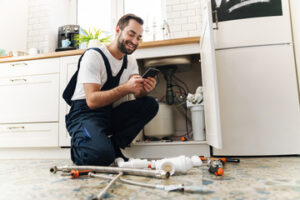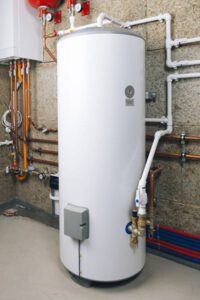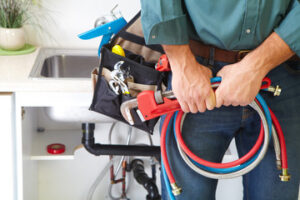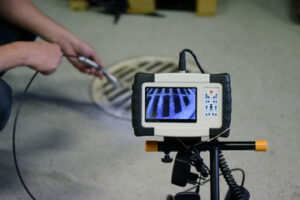Plumbing is the system of pipes that provide potable water to a building and remove wastewater. It is usually separated from the water and sewage systems that serve an entire city.
A plumbing plan is an essential component in all types of buildings. Effective plumbing maintenance protects the environment from odor and provides better sanitation. Click the https://holmes-plumbing.com/ to know more.
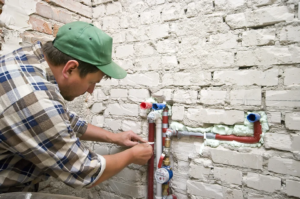
A plumbing system is comprised of pipes that transport clean water and sewage. This system is vital to our daily lives, as it allows us to enjoy clean drinking water and dispose of waste efficiently. Plumbing technicians install, repair, and maintain these systems. Plumbers use a variety of tools and parts to perform their job, including pipes, valves, faucets, tanks, and fixtures. Some parts are specialized for specific purposes, such as drains and toilets. Before installing a new plumbing system, plumbers must plan the layout and determine the size of pipes needed to accommodate fixtures. They must also ensure the pipes meet local plumbing codes and standards.
A plumber may work on residential, commercial, or industrial plumbing projects. Commercial plumbing projects typically involve larger water supply and drainage systems, while residential plumbing deals with the installation and maintenance of water heaters, pipes, and plumbing fixtures in homes. In industrial settings, plumbers often work on large-scale plumbing projects that require unique or specialized equipment.
The plumbing industry is regulated by local and state authorities. Many states have their own licensing and certification requirements for plumbers, while others leave these duties to private organizations. State regulations usually cover topics such as safety, training, and professionalism. In addition, plumbing contractors must obtain permits before beginning any work on a project.
To become a licensed plumber, individuals must complete an apprenticeship and pass a state exam. This process typically takes four or more years to complete. Individuals must also acquire the necessary skills to operate and troubleshoot plumbing equipment, such as gas and drain lines.
In order to be licensed, plumbers must keep up with industry trends and news. This helps them stay ahead of the competition and provide their customers with the best possible service.
Plumbing is a complex and important field that affects everyone in some way. It is essential to understand the basics of plumbing in order to avoid costly repairs and keep your home safe and sanitary. To learn more, contact the experienced team at GSM Plumbing. We are proud to offer comprehensive plumbing services for home and business owners in the Las Vegas area.
Maintenance
Plumbing is more than just pipes and fixtures; it’s also about maintenance, repair and replacement. Professional plumbers are trained to service a wide range of plumbing issues, including clogs, leaks, water pressure changes and more. They use specialized tools to repair or replace parts, as well as inspect and test systems to ensure they are functioning properly.
Plumbing systems serve many functions in buildings, from delivering water to rooms and bathrooms to collecting sewage waste and transporting it to a sewer system or treatment plant. Because of this, they must be well-maintained to ensure safe and reliable operation.
Residential plumbing maintenance typically includes cleaning drains and sewer lines, repairing and replacing toilets, faucets and showerheads, ensuring hot water is available, and monitoring what goes down the drains to prevent clogs or other problems. The kitchen and bathroom are the most common areas where plumbing problems occur, as food particles, soap scum, grease, hair and other waste can build up in drains and cause them to clog or overflow.
Commercial plumbing maintenance involves more extensive testing and inspection of piping, valves, water heaters and other equipment used to manage the distribution of water and sewage throughout a building. It also includes the review of water usage and consumption, as well as an analysis of potential safety or health concerns. The water quality of a building’s plumbing can impact both health and productivity, so it’s important to regularly test and maintain these systems.
While plumbing is often viewed as a less complex component of a building than electrical or mechanical systems, it’s just as crucial to the overall safety and functionality of a structure. Poor plumbing can lead to contaminated water, costly repairs and disruptions in facility operations. Regular plumbing maintenance can help reduce the risk of these issues and keep building occupants happy and healthy.
Those looking to become professional plumbers must complete an apprenticeship program that includes both classroom instruction and hands-on experience working with actual tools and pipes. They must also take an examination to receive their certification. Each province or territory has its own governing body that oversees the licensing and regulation of plumbers. In Canada, this is handled by the Ontario College of Trades and the Industry Training Authority.
Repair
Plumbing repair is the process of fixing and restoring water pipes, drains, faucets, toilets, showers, bathtubs, and other fixtures in residential or commercial buildings. It encompasses a wide range of tasks, from minor fixes like unclogging a drain to major repairs such as replacing water heaters. Plumbing repairs should be undertaken by a licensed plumber to ensure they are completed properly and safely.
Some of the most common plumbing repairs include fixing leaks, repairing clogged drains, and resolving water pressure problems. Leaks are a frequent problem, and can lead to serious damage if not repaired quickly. To prevent leaks, it’s important to regularly check your plumbing and replace worn parts.
Another common repair is fixing a dripping faucet. This is usually a simple fix, and can be done by turning off the water supply, removing the faucet, and tightening the nut or washer. It’s important to use high-quality faucets, as this will help reduce leakage.
Lastly, it’s also a good idea to clean your faucets regularly. This will help remove hard water deposits and dirt, which can cause them to drip. You can use a degreasing agent or distilled white vinegar to clean your faucets.
When hiring a plumber, it’s important to get references. This will allow you to see how other customers have experienced their work. It’s also a good idea to find out if the plumber has experience working on your type of plumbing system.
It’s important to turn off the main water supply before beginning any plumbing repairs. This will prevent any water from flowing out and potentially damaging your home or business. It’s also a good idea for homeowners to have a plan B in case the plumbing repair doesn’t go as planned.
Some of the most common plumbing repairs include replacing old faucets, repairing shower heads, and cleaning clogged drains. These can be costly, but are necessary to maintain the functionality of your plumbing system. It’s also important to make sure your pipes are in good condition and free of any cracks or holes. If you notice any of these issues, it’s best to call a plumber right away.
Replacement
Eventually, all plumbing fixtures wear out and need replacement. This includes essential items like faucets and sinks, toilets, showerheads and tubs, and more. While it is possible to delay replacement by using water conservatively, a facility’s long-term plumbing health depends on making wise choices about when to repair or replace these fixtures and fittings.
The best way to determine when plumbing needs to be replaced is to review maintenance history. Is there a pattern of repairs to a specific location or type of pipe? Has water quality recently changed, such as a noticeable change in taste or color? Discolored water is a sign of corrosion in existing pipes. Low water pressure may also indicate that a pipe is nearing the end of its life.
When deciding whether to repair or replace, consider the cost of labor and materials. It’s also worth considering how the choice will affect other areas of the building and its systems, as well as the goals of any management initiatives regarding sustainability, efficiency, or indoor environmental quality.
